The Versatile Projectors,
Screen and Sound | Read more at in70mm.com The 70mm Newsletter |
| Written by: - | Date: 01.03.2011 |
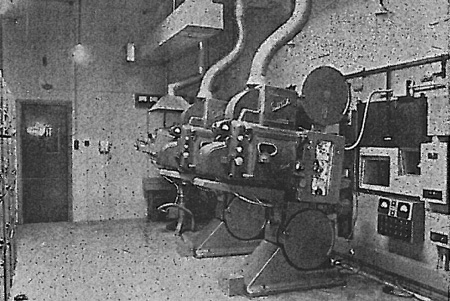 The spacious projection room at the Drake, showing
the two Philips Multi -Purpose projectors installed by Brockliss. The spacious projection room at the Drake, showing
the two Philips Multi -Purpose projectors installed by Brockliss.INSTALLATION by J Frank Brockliss Ltd., of the Philips Multi-Purpose 70/35-mm. projectors at the Drake is the third of its kind that the company has done this year. "The others were at the Dominion, Tottenham Court Road, London, and the Gaumont, Manchester. The installations were supervised by Frank Durban, director and general manager of Brockliss. This Philips projector is the only one designed to run either 70-mm. or 35-mm. film, the interchangeability being vital, since it is not to be expected that there will ever be a continual flow of films in Todd-AO. Conversion from one gauge to another takes only a few minutes, so that films of both gauges can be included on the same programme. The steadiness of the picture in the previous installations has been the subject of comment; measurements of 50 projectors have shown that vertical jump does not exceed 0.15 per cent., and side weave does not exceed 0.2 per cent.—both figures considerably better than accepted tolerances. |
More in 70mm reading: The Drake, Plymouth, England The Technical Side. We Aimed at Perfection In harmony with the new City Demonstration of Our Faith in the Future The Saga of Todd-AO DP70 / Universal 70-35 / Norelco AAII - The Todd-AO Projector Internet link: |
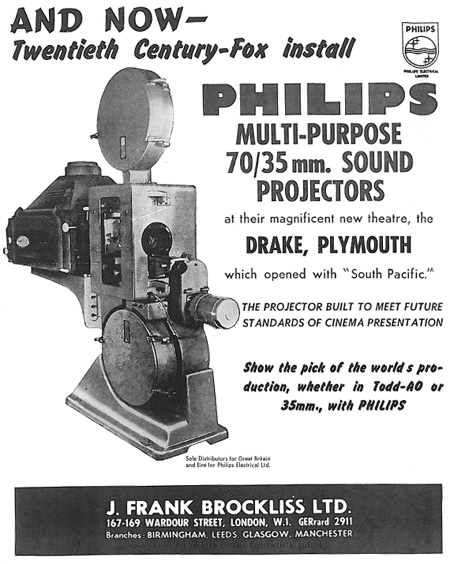 The sharpness of the picture
owes much to the projector. Obviously an aperture width of nearly two
inches would lead to severe buckling of the film were it not for the
curvature of the gate. A major difficulty heretofore in the design of a
curved gate has been to secure the accurate matching of gate runners and
skates; in the Philips projector this difficulty is overcome by the use
of flexible steel strip for the skates, which are tensioned to provide
adequate friction. The skates extend well below the gate to guide the
film on to the intermittent sprocket—an important factor in maintaining
steadiness. The sharpness of the picture
owes much to the projector. Obviously an aperture width of nearly two
inches would lead to severe buckling of the film were it not for the
curvature of the gate. A major difficulty heretofore in the design of a
curved gate has been to secure the accurate matching of gate runners and
skates; in the Philips projector this difficulty is overcome by the use
of flexible steel strip for the skates, which are tensioned to provide
adequate friction. The skates extend well below the gate to guide the
film on to the intermittent sprocket—an important factor in maintaining
steadiness.However, the cooling of the aperture plate plays an important part in preventing heating of the film. A pipe surrounds the aperture carrying cooling water; the use of heat-conducting metals for the aperture insert encourages the dissipation of heat, and after a 20-minute run at maximum arc current, the temperature of the gate does not exceed 65 deg F. Yet another factor making for sharpness and steadiness of the picture is the massive lens mount, which is made possible by reason of the fact that the lens does not have to be lifted to open the gate. The lens mount is built like a machine-tool, with a fine-thread focusing screw and a strong spring to prevent back-lash. The special Todd-AO lenses, manufactured by the American Optical Co., have been supplied by Brockliss. They are fitted with "minifiers" - negative attachments which make it possible to use lenses of shorter focus and therefore greater efficiency. Turning to sound; the magnetic sound head has a cluster of ten cores - six for Todd-AO and four for "CinemaScope". The entire cluster is well shielded, and each head has a Response curve flat to within ± 2 Db. up to a frequency of 12 kc/s. Optical sound is, of course, used only for 35mm. prints, and the sound head embodies the same magnifying system as other Philips projectors. Most installations of the Philips Multipurpose projector in other countries embody the complete Philips sound channel, but the versatility of the machine is demonstrated by the fact that at the Dominion and the Gaumont, Manchester, the sound heads feed into a GB-Kalee sound system, and at the Drake into Westrex. | |
THE SCREEN |
|
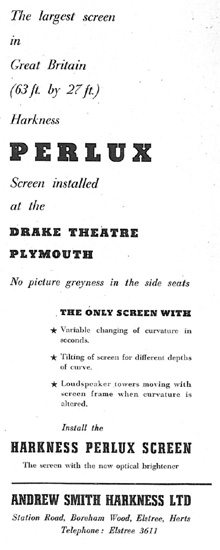 ANDREW SMITH HARKNESS LTD. has installed what is
certainly one of the largest screens in Great Britain, at the Drake,
Plymouth. ANDREW SMITH HARKNESS LTD. has installed what is
certainly one of the largest screens in Great Britain, at the Drake,
Plymouth.The company has made a special Perlux screen to measure 66 ft. x 27 ft. for fitting into a screen frame 67 ft. x 32 ft. Apart from size, however, it is, undoubtedly, one of the most outstanding installations in this country: the curvature and tilt can be altered automatically from the projection booth, from 3 ft. curvature for Anamorphic films to 8 ft. for Todd-AO presentation. Harkness' Perlux-screen was chosen because it is the screen most suitable for this installation: a silver or aluminised screen is not suitable to a deep curve due to the heavy falling off in brightness when viewed at angles. The Perlux finish maintains screen whiteness at all angles and has a uniform brightness when viewed from any part of the auditorium. The five speaker towers are also by Harkness, and the two outermost move with the screen when the curve is altered. The screen frame is also fitted with adjustable side masking. | |
THE SOUND SYSTEM |
|
 THE
Drake has been equipped by Westrex with a sound system to complement the
facilities for projecting 70mm six-track magnetic film, 35mm four-track
magnetic film and 35mm photo-track film. THE
Drake has been equipped by Westrex with a sound system to complement the
facilities for projecting 70mm six-track magnetic film, 35mm four-track
magnetic film and 35mm photo-track film.Five stage loudspeaker assemblies are provided for six-track-magnetic film, the sixth track feeding 24 two-way "ambient" loudspeakers surrounding the auditorium. Each of the five stage loudspeaker assemblies uses four low frequency units mounted in a dual horn assembly and two high frequency units. Apart from the six monitor loudspeakers in the operating box, the theatre uses a total of 44 low frequency units and 34 high frequency units. Since the screen frame is articulated the outer stage loudspeaker assemblies are mounted on mobile towers. In the operating box two banks of magnetic pre-amplifiers and two photo-track preamplifiers with push-button change-over between the banks feed six banks of power amplifiers, each of 80 watts rating. The sound main control unit includes a six-gang potentiometer and a separate potentiometer for photo-track sound together with the more usual switching facilities. The control of sound level for any type of presentation can be passed from the operating box to a corresponding unit in the auditorium located in the centre of the balcony. The mixer of a three-channel stage amplification system is also embodied in the auditorium sound control unit. The two-way loudspeakers for the stage amplification system are arranged around the proscenium arch and are fed from an independent amplifier system, the low level circuits of which embody transistors. A hi-fi type double turntable disc reproducer can feed either the stage or ambient loudspeaker systems through the main amplifier channels. An entirely independent inductive loop hearing-aid system is provided which allows any seat in the greater part of the total seating capacity of the theatre to be used by a deaf person. The deaf person will receive sound through his own personal hearing aid if it is of an appropriate and modern type. If his hearing aid does not possess inductive pick-up facilities, then these facilities can be provided by special hearing aids using external earphones provided by the theatre. |
|
PROJECTOR RECTIFICATION |
|
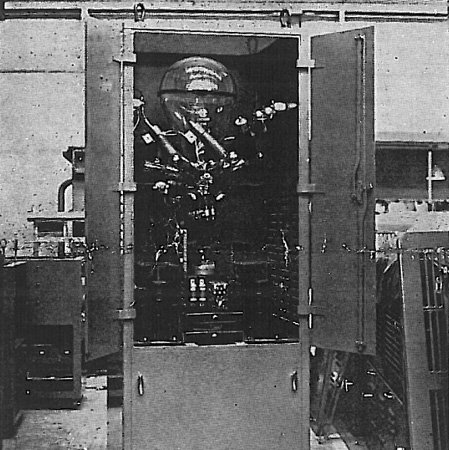 One of the Hewittic I80A
projection arc rectifiers that has been installed in Plymouth One of the Hewittic I80A
projection arc rectifiers that has been installed in PlymouthHEWITTIC glass bulb rectifiers have been installed in the Drake, Plymouth, for supplying the three Ashcraft Super Cinex projection arc lamps and the two Stelmar spot-lamps. The equipment comprises, for each projection arc, a six-phase rectifier rated for a maximum output at 180 amps; and for the spot lamps, a twin circuit three-phase rectifier, each circuit being rated for a maximum output of 80 amps. The rectifier circuits in each case are of the choke-controlled type and supply the arc lamps without the employment of any ballast resistance. |
|
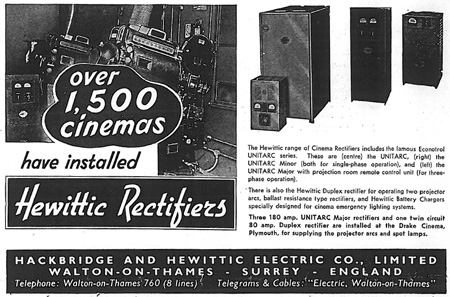 In the case of the projection
arc supply rectifiers, provision is made to cover an arc current range
of 130/180 amps, and the required arc current loading within this range
is pre-selected by means of a combination of transformer and choke
tapping adjustments. In the case of the projection
arc supply rectifiers, provision is made to cover an arc current range
of 130/180 amps, and the required arc current loading within this range
is pre-selected by means of a combination of transformer and choke
tapping adjustments.Provision is also made to give a reduced current for striking the arc followed by a direct step up to the full running value, these current values being obtained by means of remote control switches. One control panel is provided for each arc lamp, and this includes the strike and run control switches and ammeter, and voltmeter for measuring the arc current and voltage. | |
| Go: back - top - back issues - news index Updated 22-01-25 |
